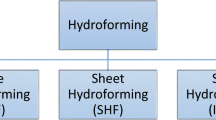Abstract
Carbon emission has become a recent global concern for green manufacturing. Production is one of the main sources of carbon emission. As the design of a product determines over 70 % of its life cycle costs, with extensive impacts on the environment, it is important to decrease the product carbon footprint in the product design stage. As the activity data is directly related to the mass of the product, the lightweight of product is a valid approach to low-carbon footprint. However, the existing lightweight design method primarily takes structure or material into consideration without the consideration of environmental factors. The product lightweight design under the low-carbon footprint constraint is proposed in this paper, which serves low-carbon footprint as an important benchmarking for product performance. This paper then presents a general lightweight design for product low-carbon footprint through structural optimization. The design of a cold heading machine is used to demonstrate the proposed methodology.
Similar content being viewed by others
References
Environmental Protection Agency. http://www.epa.gov/sustainablemanufacturing/
EIA (2010) Annual energy review 2010. p. 38. http://www.eia.gov/totalenergy/data/annual/archive/038410.pdf
Int. Energy Agency (IEA) (2008) Worldwide Trends in Energy Use and Efficiency, Key Insights from IEA Indicator Analysis. https://www.iea.org/publications/freepublications/publication/Indicators_2008.pdf
Council of the European Union, http://consilium.europa.eu/
Neugebauer R (2011) Energy-efficient product and process innovations in production engineering. CIRP J Manuf Sci Technol 4(2):127–128
Fysikopoulos A, Pastras G, Alexopoulos T, Chryssolouris G (2014) On a generalized approach to manufacturing energy efficiency. Int J Adv Manuf Technol 73(9–12):1437–1452
Galitsky C, Worrell E (2008) Energy efficiency improvement and cost saving opportunities for the vehicle assembly industry: an energy star guide for energy and plant managers. Lawrence Berkeley National Laboratory
Apostolos F, Alexios P, Georgios P, Panagiotis S, George C (2013) Energy efficiency of manufacturing processes: a critical review. Procedia CIRP 7:628–633
He B, Wang J, Huang S and Wang Y. Low-carbon product design for product life cycle. J Eng Design. doi: 10.1080/09544828.2015.1053437
He B, Wang J, Deng ZQ (2015) Cost-constrained low-carbon product design. Int J Adv Manuf Technol. doi:10.1007/s00170-015-6947-z
Accord C (2009) Draft decision-/CP. 15. In Conference of the Parties to the L NFCC, Fifteenth Session, Copenhagen, 7: 18
Bhandari M (2012) Intergovernmental Panel on Climate Change. The Wiley-Blackwell Encyclopedia of Globalization, doi: 10.1002/9780470670590
BSI PAS 2050 (2011) Specification for the assessment of the life cycle greenhouse gas emissions of goods and services. British Standards Institution
He B, Deng ZQ, Huang S, Wang J (2014) Application of unascertained number for the integration of carbon footprint in conceptual design. Proc Inst Mech Eng B J Eng Manuf. doi:10.1177/0954405414539495
Kajtaz M, Subic A, Takla M (2010) A collaborative FEA platform for rapid design of lightweight vehicle structures. Int J Veh Des 53(1):110–131
Jang GW, Yoon MS, Park JH (2010) Lightweight flatbed trailer design by using topology and thickness optimization. Struct Multi Optim 41(2):295–307
Louhichi B, Abenhaim GN, Tahan AS (2014) CAD/CAE integration: updating the CAD model after a FEM analysis. Int J Adv Manuf Technol 76(1–4):391–400
Maier M, Siegel D, Thoben KD, Niebuhr N, Hamm C (2013) Transfer of natural micro structures to bionic lightweight design proposals. J Bionic Eng 10(4):469–478
Emmelmann C, Sander P, Kranz J, Wycisk E (2011) Laser additive manufacturing and bionics: redefining lightweight design. Phys Procedia 12:364–368
Zhao L, Ma J, Wang T, Xing D (2010) Lightweight design of mechanical structures based on structural bionic methodology. J Bionic Eng 7:224–231
Obradovic J, Boria S, Belingardi G (2012) Lightweight design and crash analysis of composite frontal impact energy absorbing structures. Compos Struct 94(2):423–430
Marcelin JL (2008) Pseudo-constructal theory for shape optimization of mechanical structures. Int J Adv Manuf Technol 38(1–2):1–6
Studer M, Ehrig F (2015) Numerical shape optimization as an approach to reduce material waste in injection molding. Int J Adv Manuf Technol. doi:10.1007/s00170-014-6757-8
Chen JX, Wu G (2013) Beetle forewings: Epitome of the optimal design for lightweight composite materials. Carbohydr Polym 91(2):659–665
Goede M, Stehlin M, Rafflenbeul L, Kopp G, Beeh E (2009) Super light car—lightweight construction thanks to a multi-material design and function integration. Eur Transp Res Rev 1(1):5–10
Sakundarini N, Taha Z, Abdul-Rashid SH, Ghazila RAR (2013) Optimal multi-material selection for lightweight design of automotive body assembly incorporating recyclability. Mater Des 50:846–857
Chumrum P, Koga N, Premanond V (2015) Experimental investigation of energy and punch wear in piercing of advanced high-strength steel sheet. Int J Adv Manuf Technol. doi:10.1007/s00170-015-6902-z
Green SMF, Brooke NJ, McSaveney LG, Ingham JM (2011) Mixture design development and performance verification of structural lightweight pumice aggregate concrete. J Mater Civ Eng 23(8):1211–1219
Lin DS, Yang YS, Cao GR, Tian Y, Ruan ZY, An GP (1998) Forging machinery and finite element analysis. Beijing University of Technology Press, Beijing
Wen JB, He HB (2013) Numerical simulation and analysis of three dimensional flow field of a counter-rotating fan with various angles. Int J Control Autom 6(6):127–138
Author information
Authors and Affiliations
Corresponding author
Rights and permissions
About this article
Cite this article
He, B., Tang, W., Huang, S. et al. Towards low-carbon product architecture using structural optimization for lightweight. Int J Adv Manuf Technol 83, 1419–1429 (2016). https://doi.org/10.1007/s00170-015-7676-z
Received:
Accepted:
Published:
Issue Date:
DOI: https://doi.org/10.1007/s00170-015-7676-z




